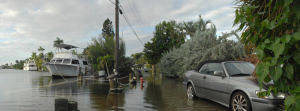
BATON ROUGE, La. – Aug. 17, 2016 – Due to recent flooding in Louisiana, FEMA’s National Flood Insurance Program (NFIP) is offering the following tips on what to do after a flood to ensure that local residents are aware of hazards as they re-enter flooded areas and guidance on filing flood insurance claims for those who have coverage through the NFIP.
“We encourage area residents who are not insured for flooding to protect themselves from the financial costs of future floods by obtaining flood insurance through the NFIP (National Flood Insurance Program),” FEMA adds. “You can learn about the NFIP and FloodSmart, the marketing and education campaign of the NFIP, by visiting FloodSmart.gov.
During a flood
Move to high ground. When it floods, go to higher ground. Avoid areas subject to flooding. Be aware of streams, drainage channels and areas known to flood so you’re not cut off from your evacuation routes.
Watch out for water. Don’t walk across flowing streams or drive on flooded roads. Moving water just six inches deep can knock you off your feet and cause an injury. Even two feet of water is enough to sweep a car off the road.
Listen for updates. Listen to the radio or TV for information. Be sure to follow the instructions of local authorities.
Turn off power. Turn off all utilities at the main power switch and close the main gas valve if advised to do so. Don’t touch any electrical devices if you’re wet or in standing water.
After a flood
Check for damage. Check for structural damage before re-entering your home. If you suspect damage to water, gas, electric or sewer lines, contact authorities.
Remove wet items. Immediately remove wet carpeting, furniture and bedding. Any item holding moisture can develop mold within 24 to 48 hours. Clean and disinfect everything touched by floodwaters. Get cleanup tips at the Center for Disease and Control’s website.
Plan before you repair. The rebuilding decisions you make now to lower your risk and insurance costs can result in big benefits over the long term. Contact your local building inspection or planning office or your county clerk’s office to get more information.
File your flood insurance claim. To file your claim, you’ll need your insurance company’s name, your policy number and a phone number where you can be reached. Take photos of any water in the house and anything damaged in your home. Make a detailed list of all damaged or lost items.
Ask about disaster assistance. Federal disaster assistance might be available if the president has declared a federal disaster. When available, this assistance typically comes in the form of a loan and must be paid back with interest.
Rebuilding
Understand your flood insurance claim and policy. If you have questions, call 800-621-3362 and use Option 2.
Get a repair permit from your local building official. A substantial damage determination is required for building repairs in the Special Flood Hazard Area. A building that is damaged to 50 percent of its market value or greater is considered a substantially damaged building, which requires that all repairs meet local flood damage prevention ordinances. That determination is a factor in future premium rating for a flood insurance policy and is needed for Increased Cost of Compliance claims.
Learn more about ICC (Increased Cost of Compliance Coverage). You may be able to obtain up to an additional $30,000 toward elevating, relocating, or demolishing your home to comply with the local floodplain management requirements. Ask your adjustor about opening an ICC claim.
Ask about mitigation grants. Grants for elevating homes may become available because of the flood event. Ask officials about applying to the State of Louisiana on your behalf for Hazard Mitigation Grant Program funding.
For more information



This post has 0 Comments